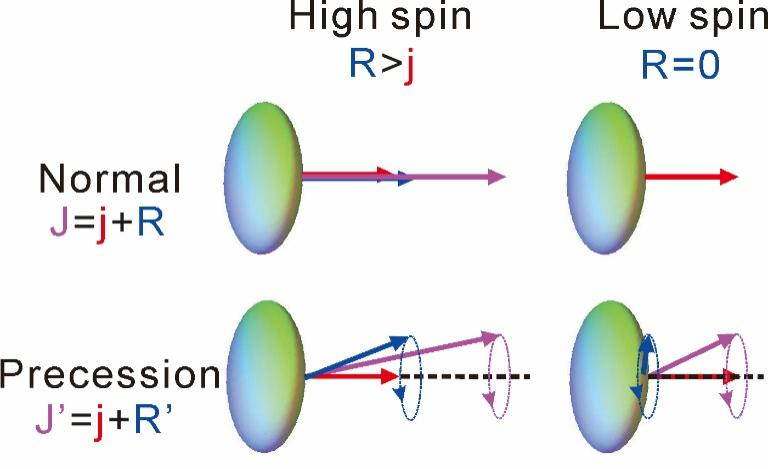A research team led by the scientists at the Institute of Modern Physics (IMP) of the Chinese Academy of Sciences (CAS) has explored the nature of the reported low-spin wobbling bands in atomic nuclei. New investigation suggests that the nuclear wobbling interpretation is not feasible at low spins. The study was published in Physics Letters B.
Researchers revealed the problems in these works on low-spin wobbling bands. Based on harmonic approximation, wobbling is feasible when the total angular momentum is mainly distributed on one principal axis, while the components on the other two are much smaller. The study indicated, however, it cannot be fulfilled at low spins.
To unveil the nature of the reported low-spin wobbling bands, one among them in aurum-187 was selected to be studied again via an independent experiment. That band was assigned to be a wobbling band in a previous study published in Physics Review Letters. The critical experimental proof—enhanced electric transition component—was deduced by angular distribution measurement performed at the Argonne National Laboratory in U.S. using GAMMASHPERE, which was regarded as one of the world’s most powerful germanium detector arrays. However, linear polarization measurement was absent in that work, which induced ambiguity into the experimental results.
Researchers conducted the new experiment at the Heavy Ion Research Facility in Lanzhou (HIRFL), China. They reinvestigated the reported band in aurum-187 through both angular distribution and linear polarization measurement. For the latter, it is suitable to be performed by the detectors array in Lanzhou, which consists of 8 Clover detectors perpendicular to the beam direction.
According to the experimental results, researchers found that the reported band in aurum-187 is an ordinary rotational band, which is generated by dominant single-particle excitation and cannot be associated with wobbling.
Based on the overall assessment, the study concluded that the experimental and theoretical evidence for the reported low-spin wobbling bands is generally insufficient. Since the feasibility of wobbling has been excluded at low spin, a new theoretical model to describe low-spin nuclear precession is required. For this purpose, more experimental research is needed to provide convincing evidence in this field.
This work was supported by the Strategic Priority Research Program of CAS, the National Key R&D Program of China, the Key Research Program of CAS, and the National Natural Science Foundation of China.

Figure 1. Angular momentum geometry of nuclear precession. Normal (upper) and precession (lower) modes for high-spin (left) and low-spin (right) systems are sketched in the body fixed frame of an odd-A triaxial nucleus. (Image by GUO Song)
Contact:
LIU Fang
Institute of Modern Physics

